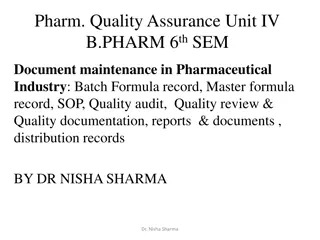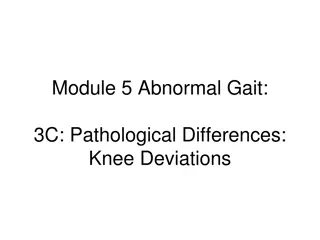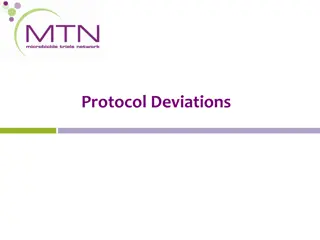Bridge circuits and their applications
Bridge circuits are commonly used for precision measurement of component values such as resistance, inductance, and capacitance. The Wheatstone bridge, a type of bridge circuit, is particularly useful for measuring small changes in resistance, making it ideal for sensor applications. By comparing un
1 views • 16 slides
Presentation to the Portfolio Committee on Higher Education, Science and Innovation(PCHESI)
Mrs. Sesi Nombulelo Nxesi, CEO, presented the Education, Training, and Development Practices Sector Authority's annual report to the Portfolio Committee on Higher Education, Science, and Innovation. The presentation covered overall performance, scope of coverage, responses to underperformance, and a
0 views • 31 slides
Deviations in Procurement Process
Dive into the world of deviations in procurement, from defining terms to exploring examples and thresholds. Learn how deviations impact the standard procurement procedure and the importance of compliance with regulations and policies.
3 views • 78 slides
Impact of Frequency Oscillation on Generator Operation: Emergency Conditions Analysis
Analyzing the impact of frequency oscillation and low frequency on generator operation during emergency conditions. Investigating how lower frequency affects units' ability to respond to deviations, system stability, and load shedding processes. Examining system responses during Energy Emergency Ale
1 views • 31 slides
Batch Record Maintenance in Pharmaceutical Industry: Essential Guidelines and Requirements
Detailed documentation is crucial in the pharmaceutical industry to ensure the quality and consistency of each batch of products. Batch records, consisting of batch processing and packaging records, contain vital information such as product details, processing stages, personnel responsibilities, equ
1 views • 45 slides
Civil Air Patrol Operations Procedures and Philosophy
Explore the comprehensive operations procedures and philosophy of the Civil Air Patrol (CAP), emphasizing the importance of professionalism, teamwork, and adherence to standards. Learn about the core procedures, mission planning, briefing, risk assessment, and the ultimate responsibility of the pilo
0 views • 8 slides
Impact of COVID-19 on Data Analysis and Comparability Over Time
The COVID-19 pandemic has significantly affected data analysis processes, with changes in data items, census reference dates, and collection methodologies. This has led to challenges in maintaining comparability over time. The presentation covers the background, changes in data items, South African
0 views • 12 slides
Ensuring Protocol Compliance and Corrective Action Plans in Clinical Trials
This content discusses the importance of creating Corrective Action and Preventive Action (CAPA) plans for protocol deviations in clinical trials. It covers the components of a CAPA, best practices for creating CAPAs for different deviation types, and regulatory compliance requirements according to
1 views • 33 slides
Effective Protocol Deviation Management in Clinical Research
Understand the importance of handling protocol deviations in clinical trials to ensure patient safety, data integrity, and compliance with regulatory requirements. Explore SOPs, electronic systems, and best practices for managing deviations effectively. Learn about GCP requirements, DMC usefulness,
0 views • 22 slides
Insight into Kinetic Theory of Gases and Maxwell Velocity Distribution
The discussion delves into the kinetic theory of gases, highlighting the deviations from ideal gas behavior and the derivation of the Maxwell velocity distribution. It explores the intricacies of molecule-wall collisions, Maxwell's assumptions, the Gaussian distribution, and the concept of reversibl
0 views • 8 slides
High-Level Overview of Purchasing Process for Various Purchase Categories
This training presented by Tamara Cline offers a high-level explanation of the purchasing process for purchases exceeding $10,000, between $10,000 and $88,300, over $88,300, and public works. It covers process deviations resulting in audit findings and corrective action plans without detailed requis
0 views • 20 slides
Simplification of Issue Labelling and Activity Updates in MAD-X: Jan-May 2022
The MAD-X team has been actively addressing issues, closing bug reports, and merging Pull Requests to enhance their codebase from January to May 2022. The team has simplified issue labelling, closed various issues that can be addressed by pull requests, and updated their system for better efficiency
0 views • 20 slides
Resolving Data Quality Issues Prior to Transition at EPA
This content covers the process of resolving data quality issues before transitioning data at the U.S. Environmental Protection Agency (EPA). It includes information on different types of data quality checks, reviews, and corrections conducted by the EPA to ensure accurate and reliable data. The con
1 views • 9 slides
Examination of Components of Fiscal Policy Paper Laid Before Parliament
An independent auditor's report on the Fiscal Policy Paper laid before Parliament on February 18, 2021, is reviewed. The Auditor General of Jamaica examined the components of the paper, ensuring compliance with the Financial Administration & Audit Act. The report covers conventions, assumptions, pub
0 views • 12 slides
Ideal Orbit Feedback for Ultra-low Emittance Rings Workshop Summary
The workshop on Ideal Orbit Feedback for Ultra-low Emittance Rings by Guenther Rehm at CERN in January 2018 covered topics such as Orbit Feedback Motivation, Bandwidth, Latency, Control Techniques, and References for further reading. The presentation highlighted the importance of precise beam positi
1 views • 27 slides
Data Collection and Analysis Summary for Rubber Mix Project
Collection of dielectric data for different depths and locations on Interstate 295 and Route 201 in Portland and Moscow. Distribution curves and calibration findings revealed deviations in dielectric values at various depths on different dates. Further analysis required to determine the next steps f
2 views • 13 slides
Impact of Human vs. Systems Factors on Demand Planning Performance
Exploring the impact of human vs. systems factors on demand planning performance in supply chain management is crucial for achieving competitiveness. Effective planning is essential for coordination and execution of customer orders, but issues such as deviations from original plans and unnecessary i
1 views • 14 slides
Facial Plastic Surgery Review and Insights
Explore the intricate details of facial analysis, facelift procedures, forehead anatomy, and cleft lip deviations through a comprehensive inservice review. From understanding the Frankfort horizontal plane to identifying the most commonly injured nerves, this content provides valuable insights into
0 views • 44 slides
Sequential Search with Offer Freezing: Theory and Experimental Evidence
This paper explores the concept of offer freezing in sequential search scenarios, particularly in the context of airline ticket pricing. A theoretical model is constructed to analyze the implications of price freezing options, followed by an experimental evaluation of the model's predictions. The st
1 views • 49 slides
Short-Range Tests of Gravity: Theoretical Physics Project Overview
This project focuses on calculating modifications to the Newtonian gravitational force through experimental short-range tests of gravity. Utilizing the Standard-Model Extension (SME) test framework to search for potential violations of General Relativity and Newtonian Gravity. Key objectives include
1 views • 7 slides
Machine Learning for Molten Salt Reactor Safeguards
Molten salt reactors face challenges in material accounting due to liquid fuel which precludes traditional safeguards. This project proposes a two-step approach involving the development of measurement signatures created by material diversion, and a machine learning model to distinguish normal react
1 views • 18 slides
Pathological Differences in Hip Joint Variations: Abnormal Gait Analysis
Understanding pathological gait variations related to hip joint differences is crucial in gait analysis. Excessive sagittal, coronal, and transverse plane motions impact stance and swing phases, leading to deviations in gait patterns. Excess flexion, limited flexion, past retraction, excess adductio
0 views • 13 slides
Pathological Knee Variations in Gait Analysis
Explore different knee deviations in gait analysis, such as limited knee flexion, knee hyperextension, extensor thrust, and excess knee flexion. Learn how these deviations disrupt normal gait patterns, impact muscle demands, and affect shock absorption during various phases of the gait cycle.
1 views • 19 slides
Noida Power Company Limited True-up and ARR Summary for FY 2021-22
The document presents the true-up and annual revenue requirement (ARR) details for Noida Power Company Limited for the fiscal year 2021-22. It includes components of ARR, variance analysis, revenue surplus details, expenses breakdown, and other financial aspects. The report highlights deviations, re
0 views • 44 slides
Impact of Board Thickness Deviations on Wire Displacement
In this study by Lee Greenler at UW Physical Sciences Lab, the effect of side and foot board thickness deviations on wire position was analyzed. The displacement of the wire was found to vary based on the cosine factor, with potential displacements up to ~0.5mm near the pin. Different cases were con
0 views • 5 slides
Evolution of Vertical Flight Planning Challenges in Aviation
In the past, flight plans were static, but now they are dynamic and automated, leading to more level changes during cruise. This evolution poses challenges for air traffic control and flight planning, as shown in practical examples of flight route deviations. The shift signifies the need for enhance
0 views • 16 slides
Overview of BSAI Pacific Ocean Perch Model Structure and Recent Developments
The BSAI Pacific Ocean Perch assessment model has evolved over the years, with a history dating back to pre-2000. Recent developments include the combination of separate models for AI and EBS, adjustments to age error matrices, and enhancements in handling composition data. The model structure focus
0 views • 60 slides
Overview of Czech Criminal Procedure: Principles and Process
Czech criminal procedure combines inquisitorial and accusatorial models, with the pre-trial phase led by the public prosecutor and the trial phase overseen by a judge. Inspired by the Anglo-American adversarial system, Czech proceedings feature deviations tailored to the continental model. Key princ
0 views • 44 slides
Enhancing IACUC Effectiveness: VA Perspective Workshop Insights
Gain valuable insights into optimizing IACUC processes from the VA's Chief Veterinary Medical Officer and experts. Topics include addressing deficiencies, managing Guide deviations, AAALAC site visit issues, and VA updates. Discover the importance of identifying and rectifying departures from regula
0 views • 45 slides
Guidelines for Evaluating Departures from the Guide
Understand the definitions of standards, deviations, and departures in animal research protocols. Learn to differentiate between perceived and true departures, evaluate their impacts, and identify reporting requirements. Experienced IACUC members and administrators can develop essential skills to en
0 views • 30 slides
Design and Verification of Autonomous System Controllers
Explore the challenges of designing autonomous system controllers under timing uncertainties, focusing on quantitative safety measures to ensure the robot maneuvers safely despite deadline misses. The study delves into implementing controllers, analyzing trajectory deviations under different scenari
0 views • 18 slides
ACORP Appendix 9: Documentation of Approved Protocol Departures
Appendix 9 serves to document departures approved by the IACUC for a given protocol, allowing inclusion in semiannual reports. It guides users on identifying departures, using the VA Deviations and Departures flowchart, and provides examples for clarity. Criteria for when to use Appendix 9 are outli
0 views • 12 slides
Deviations and Waivers in Special Education: February 2024 Webinar Insights
The February 2024 Office of Special Education Technical Assistance webinar focuses on deviations, waivers, and ISD plans, aiming to clarify the distinctions between deviations and waivers in special education, providing insights into laws and rules guiding these processes, and outlining application
0 views • 35 slides
Essential Guidelines for Ping Pong Parachute Competition 2022
Ensure compliance with specific requirements for your pressure vessel, documentation, launcher, and design when participating in the Ping Pong Parachute event. Follow the rules diligently, use proper equipment, and refer to official clarifications and FAQs for assistance. Take note of potential devi
0 views • 5 slides
Advanced Analysis in Pharmacy: Deviations from Beer-Lambert Law
Explore the complexities of advanced analysis in pharmacy through deviations from Beer-Lambert Law, including real, instrumental, and chemical deviations. Understand limitations, causes of nonlinearity, and the role of instrumentation in spectrophotometry. Dive into topics such as irregular and regu
0 views • 41 slides
Measurement of Higgs Boson Yukawa Couplings and Branching Fractions in CEPC Experiment
The study focuses on measuring the Yukawa couplings between the Higgs boson and Standard Model fermions to understand fermions' masses and potential deviations indicating new physics. The analysis aims to measure Higgs decays to bb, cc, and gg at the CEPC experiment through event selection criteria,
0 views • 8 slides
Role of Solvent in Spectral Properties and Solvatochromism
Solvent plays a crucial role in physical and chemical processes, affecting kinetics, equilibria, and spectral properties such as UV-vis, IR, and NMR. Solvathochromism describes the change in spectral bands caused by solvent interactions. Factors like solvent polarity and hydrogen bonding influence d
0 views • 19 slides
Time Transfer Statistics in Technical Services
Time transfer in technical services involves transmitting time information between locations, with a focus on statistical measures like Time Deviation (TDEV). This process assesses the noise affecting systems using specialized tools for time and frequency stability analysis. The performance of time
0 views • 29 slides
Protocol Deviations in Clinical Trials
Protocol deviations are expected occurrences in clinical trials that may arise from site or participant actions. It is crucial for research teams to identify, report, and learn from these deviations to ensure the integrity and safety of the study. Mechanisms for identifying and reporting deviations,
0 views • 16 slides
Ensuring Compliance in Human Research Programs at Yale University
Yale University's Human Research Protection Program (HRPP) emphasizes the importance of preventing and addressing deviations in research practices. Led by experienced compliance managers, the HRPP RQA&C team at Yale focuses on conducting reviews, responding to research complaints, and developing eff
0 views • 32 slides







































